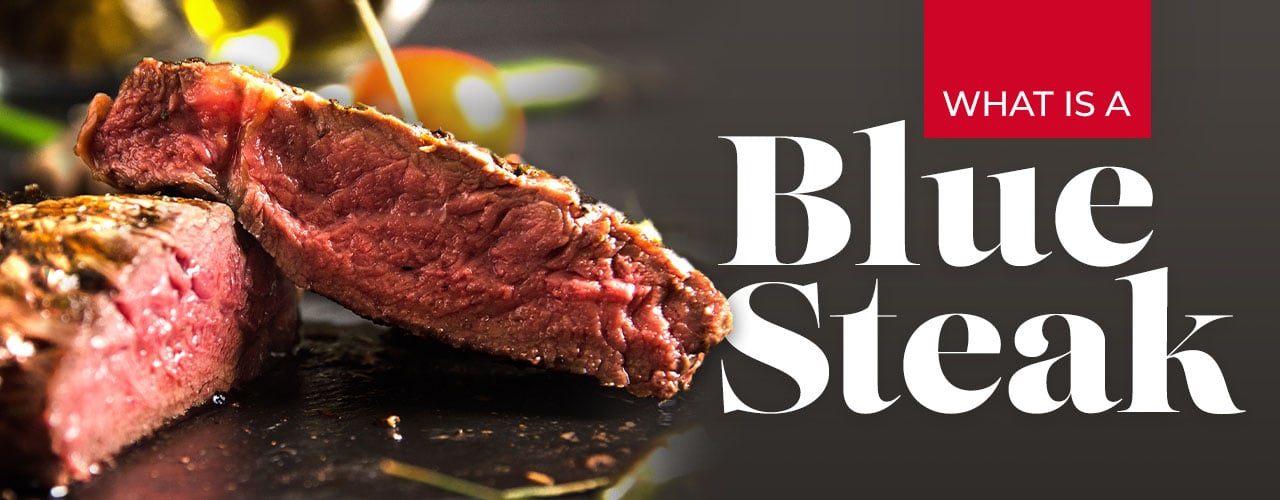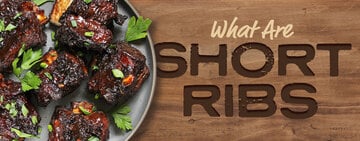What Is a Blue Steak?
Last updated on Mar 6, 2024Kevin SinghelBlue steak, also known as extra rare steak or blue rare steak, is a steak that is lightly seared on the outside yet red on the inside. To achieve this, blue steak is cooked for a very short period of time. The result is a steak that is soft and tender, perfect for those that love that melt-in-your-mouth texture. Whether you're readying to open a butcher shop or looking for new ways to prepare your restaurant's steaks, understanding what blue steak is and how to prepare it is critical.
Shop All Steak ProductsUse these links to learn more about blue steaks and how to prepare them.
How to Cook Blue Steak

To cook a blue steak, start by bringing the steak out and letting it reach room temperature. After adding seasonings and spices, place the steak on a high heat grill. Sear each side for a minute, before letting the steak cook on the edges of the grill for a few seconds. When using a meat thermometer, the temperature should read between 115-120 degrees Fahrenheit when finished.
If done correctly, the outside should be slightly seared while the rest of the steak looks red and almost raw. Before serving, let your steak rest for a few moments so it can reabsorb and distribute juices that were constricted during grilling. The short amount of time and low internal temperature required to cook blue rare steaks can be tricky for beginner grillers to master, so it may take a few times before you cook the perfect blue steak.
Blue Steak vs Rare
If you're unfamiliar with steak preparation, you may believe that rare steaks are the least cooked stage on the steak doneness chart, but blue steaks take that honor. Rare steaks are cooked longer than blue steaks and result in a more cooked interior and a warmer center. Those that love the tenderness and softness of rare steaks will find themselves enjoying the same qualities in blue steaks.
Is Blue Steak Safe?

Since blue rare steaks are cooked for such a short time, many people have questions about the health and safety of eating a blue steak. Studies have shown that bacteria like E.coli are found on the outside of the steak, so cooking the outside eliminates the bacteria.
Although consuming raw and undercooked foods can be dangerous, eating a properly prepared blue steak is safe. The safest way to serve steak is with an internal temperature of at least 140 degrees Fahrenheit. Even though rare steaks are served below this temperature all the time, you may want to include a disclaimer in your menu warning consumers that "Consuming raw or undercooked meats, poultry, seafood, shellfish, or eggs may increase your risk of foodborne illness."
Blue Steak Safety Tips
Properly prepared blue steaks are safe to consume, but you need to follow food safety guidelines when preparing them. For example, to avoid illness you should always clean and sterilize your tongs after transferring raw meat with them. You also should ensure that the outside of your steak is completely seared before serving, just to guarantee that bacteria such as E. coli is eliminated.
Black and Blue Steak

A very similar style to cooking steak is known as a black and blue steak. Much like a blue steak, the inside of a black and blue steak is red and hardly cooked. A black and blue steak differs in that the outside is charred rather than seared, giving the steak the unique combination of a charred well-done outside with a tender red inside.
Pittsburgh Blue Steak
A black and blue steak is sometimes referred to as a Pittsburgh blue steak or a Pittsburgh style steak. The name Pittsburgh steak dates back to Pittsburgh steel mills during the industrial era. Stories state that steel mill workers would bring steaks to work for lunch and cook them on the hot factory equipment. The hot factory equipment would quickly char the outside of the steak and leave the inside red, allowing the workers to cook the steaks on their short lunch breaks.
How to Cook Black and Blue Steak
Rather than use a cast-iron skillet, to cook a black and blue steak you'll need to have an open flame grill set to the highest setting. Place a type of shortening such as steak fat trimmings from a well-marbled cut or butter around the outside of the steak. The melting fat will cause flames to rise higher and the temperature to get hotter, allowing you to quickly char the outside of the steak. Cook the steaks for around 1 to 2 minutes on each side or until the steaks are charred on the outside and have an internal temperature is around 115-120 degrees Fahrenheit.
Best Cuts for Blue Steak

Cooking a steak melts the meat’s fat and breaks down the steak’s marble. When you’re cooking a blue rare steak, the meat is cooked for a short period of time, meaning not a lot of fat is melted. For this reason, lean cuts that contain little fat are the best options for cooking blue steak. Here are some of the best cuts of steak for cooking your blue steak:
- Tenderloin - Tenderloin is a cut from the loin of the cow. Because this part of the body does not bear any muscle, there is very little fat and tissue on the cut. For this reason, tenderloin is one of the most tender cuts of beef, making it perfect for blue steaks.
- Flat Iron - Flat iron steaks come from the chuck or shoulder area of a cow. Many consider flat iron steaks the second-most tender cut behind the tenderloin. In the past flat iron steaks were known as “butler steaks” since they were perceived as low-quality and unusable. Recent innovations have allowed for connective tissue to be trimmed from the cut, resulting in the tender flat iron we know today.
- Sirloin Tip - Sirloin Tip cuts come from the rear leg of the cow, an area known as the round. Due to the location of the cut, there is some weight-bearing muscle that makes this cut less tender than tenderloin and flat iron steaks. Despite this sirloin tip is still fairly tender and full of flavor, making it a quality option for blue steak.
Blue steak is the rarest and most tender way to prepare a steak, making it an essential part of menus in steakhouses and restaurants. Understanding how to properly and safely prepare blue steak allows your establishment to offer a better dining experience and add a new style of preparation to your menu.



